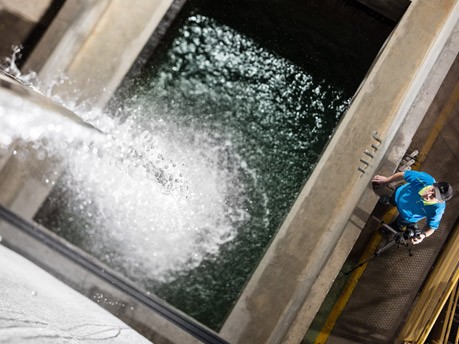
Sectors of application
Urban planning / River and maritime port infrastructures / Offshore industry
Our offer
- We propose a cross-cutting offer in hydraulic and environmental sciences, in order to have a comprehensive understanding of the issues:
- Digital and experimental modelling of river and sea flows, morphological changes, swell and ecology
- Assess the force exerted on structures by currents and wave loads, with a view to their sizing
- Assess natural risks: floods, low flows, clogging of industrial installations (sediments, fish, plants and algae)
- Simulate the behaviour of chemical substances in surface waters, agricultural soils, the atmosphere, aquatic organisms, plants, mammals and the human organism
Your challenges
- To understand the operation of an ecosystem at coastal or watershed level, and interactions with urban and industrial installations
- To assess the natural risks
- To assess the ecological status and impact of an industrial installation or development
- To think up innovative solutions to mitigate anthropogenic effects: fish-ways, renaturation of waterways, etc.
- To predict the effects of global warming
- To manage the multiple uses of water with respect to your needs
- To size your river and coastal infrastructures
Our strengths
- Assessment resources used in support of EDF's hydraulic safety and environmental issues since 1946
- Transparency in the implementation of assessments
- A broad, comprehensive offer that enables each problem to be accurately dealt with
- Mastery of calculation tools through involvement in their very development
Use case examples
Artelia, CEREMA, HR Wallingford: Since 2011, EDF tools have been co-distributed under Open Source licence through the openTELEMAC consortium (opentelemac.org), within which these major public and private design offices are involved. These tools are used by the French flood forecasting department (SCHAPI, SPC).
ONEMA: A partner since the 1980s, this organisation relies on the EDF R&D division to reinforce its expertise in fish migration and fish-way sizing.
EDF Énergies Nouvelles: Several studies have been and are being carried out for our subsidiary, including the design of offshore wind turbine foundations, the modeling of floating wind turbines, the operational conditions of maintenance vessels, and Metocean expertise (long-term monitoring of wind, wave, and current measurements at a maritime site in order to extract statistics on natural conditions), etc

